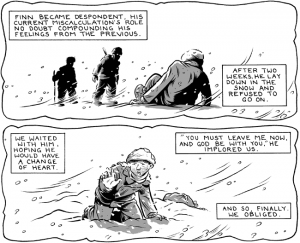Here’s another review of Midnight Sun that’s appeared on those crazy internets. This one’s from Greg Burgas of “Comics Should be Good” who had reviewed the first installment of the now-canceled serialized run of the book and, though generally liking the setup, felt that a self-contained book would have been a better package from the get-go given the pacing of the storytelling. Now, reading the whole thing beginning-to-end as a graphic novel though, he gives it quite a favorable review, saying that it would potentially have made his “best of” 2007 list, had that list gone to ten rather than five (insert Spinal Tap joke here).
Greg astutely notes one aspect of the story that gave me some real trouble when putting Midnight Sun together: untrustworthy narrators. He mentions this specifically when citing from the book, “People (who) tell their stories about what happened, but they may be lying or have incomplete information.” Having a story relayed by an untrustworthy narrator is a longstanding literary device in prose fiction that’s been used to great effect, for example, in one of my favorite novels, Lolita, by Vladimir Nabokov. The device that really drives Lolita is specifically its untrustworthy narrator, Humbert Humbert, who relays the story of his bizarre and immoral “romance” with a child in such a way that the book becomes a black comedy because of the obvious contrast between his version of the events—in which he makes himself out as some sort of victim—and what we, the readers, can clearly deduce is the real and quite inverse story behind this narration.
But for us comics folk, this is a pretty hard trick to pull off. In comics, like its distant cousin film, the visual element is there, smack in front of the viewer, with a weight and authority that says THIS is what happened. Pictures have a sort of existential authority that prose does not necessarily have, particularly prose that we know to be from an unreliable source. But in comics, even when a bit of first-person dialog is placed in a caption box over an image, the image will tend to be seen by the reader as an accurate telling of events, and getting around that can be difficult. Here’s the best I could do for a solution to this in Midnight Sun: on this page a narrator, about whom cannibalism will later be implied, is relaying how he (claims he) abandoned a fellow crewman at that crewman’s specific request:
The problem here, of course, is that when the prospect of cannibalism is brought up a page or two later, the reader will likely flip back and review the narrator’s version of events and, more important, the images in each panel. In light of this prospect, what I attempted to do here was to pose the main figure (the one who was either left behind at his own request, or was possibly killed and devoured, depending on who you believe) such that his gestures and facial expressions could be interpreted first go-round as that of someone desperate and miserable, asking to be left to die, yet could also be read in light of later innuendo as a person being threatened by aggressors and pleading for mercy.
Now, whether I was wholly successful at this (or, really, whether anyone would even bother to look back a few pages!) is something that the book’s readers, not I, can say…


Recent Comments